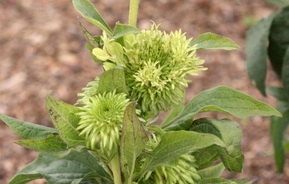‘Green Envy’ is a cone flower that is bred to have a green color, however, if your pink coneflowers start to turn green do not gleefully suppose that you have developed a new and fascinating cultivar. Coneflowers are susceptible to a disease called aster yellows. Caused by an organism called a phytoplasma, aster yellows causes the flowers of the pink coneflower to become distorted. They remain green and never develop their normal color. The leaves may become chlorotic with the yellow leaf divided by green veins. The plant may not achieve its normal height and the stems may be numerous but spindly. Seeds do not develop in flowers affected by aster yellows.
Aster yellows is transmitted by the leafhopper and by direct transmission from the grafting of plants. Once the bacteria like phytoplasma infects a plant there is no cure. Infected plants should be destroyed immediately to prevent the spread of the disease. The phytoplama unfortunately overwinters in perennials and biennials.
perennials and biennials.
In our area leafhoppers do not survive the winter but arrive in the spring from storms blowing in from the Gulf of Mexico. They ride the winds from the southern states, where they overwinter, sweeping in from the Midwest to the East in as little as 5 days. Once they make their arrival they begin feeding on plants. Even if they aren’t carrying the disease when they arrive they pick up the pathogen as they begin feeding on infected plants. The leaf hoppers ingest the phytoplasma and it multiplies in the insect’s gut. As they continue to feed, they spread the disease to healthy plants.
There are no insecticides suggested for the control of leafhoppers in the home garden. The number of leafhoppers and the conditions that affect their feeding pattern are the controlling factor in the spread of aster yellows. Hot dry conditions that decrease the growth of plants will also slow the feeding of leafhoppers. Abundant rain that encourages lush vegetative growth encourages feeding and will speed up the spread of the disease. At low temperatures symptoms may not manifest in plants that are infected but as conditions change the signs of the disease become apparent.
While there is no definitive treatment for Aster yellows and no way to eliminate the leaf hoppers there are some steps that can be taken to keep this disease out of the garden. The first step is to watch plants carefully and remove anything that appears to be infected. Since the disease in incurable the plants will never recover and will serve as a source of infection for other plants. If Aster yellows is prevalent discourage the organism by planting ornamentals that are immune. These include verbena, salvia, nicotiana, geranium, cockscomb, and impatiens. Covering plants with mesh to keep the leafhoppers from feeding is effective but is probably only practical for vegetables or a few prized perennials. Perennials cannot be kept covered indefinitely but with good gardening practices and cold whether there is always the hope that the disease causing organisms will be eliminated. Some growers use aluminum foil around the plants in the hope that the reflected light will confuse the leafhoppers. The removal of weeds from the surrounding area is a vital step. Concentrate especially on dandelions and plantain that are secondary hosts and plants that are most likely to serve as an overwintering domicile for the pathogens.